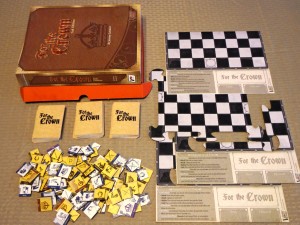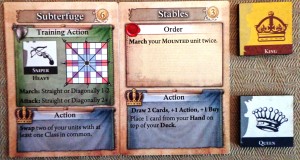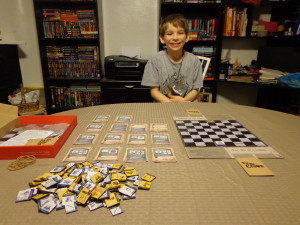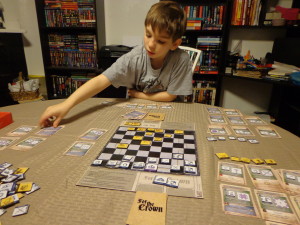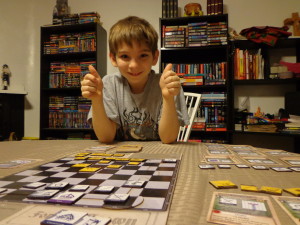As an avid chess player and a former member of the United States Chess Federation, it goes without saying that I know my way around the chessboard. “For the Crown: 2nd Edition” showed up unexpectedly on my doorstep just the other day and I was surprised to learn that the game not only had a chess theme to it, but also deck-building mechanics. This is probably the only time I’ll ever be able to use “chess” and “deck-building” in the same sentence, so forgive me if I spontaneously combust with excitement periodically throughout the review. Before we take a look at this game in further detail, I’d like to thank Stephanie Marroquin from Victory Point Games for sending me a free review copy. It’s worth noting that there is a polybag version and a boxed version…the components I mention and the pictures you’ll see represent that of the boxed version.
Components
Game Board – Two game boards were included with my game. Both looked the same, except one of them was made of thicker material and could be taken apart / put together via a jigsaw mechanic. Both game boards contain a standard eight by eight grid with alternating black and white squares, similar to that of a chessboard. Turn instructions are listed on either end for players to reference, along with spaces for a barracks, deck, and discard pile.
Units – These square, laser-cut game pieces represent a player’s army. Some of these units resemble the look and movement of your every day chess piece while others are completely new. Players will be calling forth these units and moving them around the board.
Cards – These cards are used for the deck-building portion of the game and contain various effects for players to utilize. Not all cards have the same actions on them. Players will be using these cards to train units into their barracks, buy new cards for their deck, and other card specific actions.
Odds and Ends – The game came with some additional baggies, a charcoal desiccant packet, a rulebook, and a “Wipes-A-Lot” napkin. More on these items later.
Setup & Gameplay
First, the cards are separated into stacks by name, similar to that of any deck-building game. Each player will take six peon cards and four guard cards and shuffle them together to form their individual face-down starter decks, drawing five cards for their beginning hand. Next, players will pick which decks to include in their game. They’ll include the four main core decks (champion, clergy, tower, and consort) and add ten additional decks of their chosing. Those decks not used are put away. Each player puts a king unit on the appropriately marked starting square on the game board.
To sum up the gameplay, players will start only with a king unit, but will be using their deck to acquire new cards and ultimately, more units for the board. A player’s turn consists of the following:
1. Order Phase – The player may move or attack with an existing unit on the board, deploy a unit from their barracks onto their first rank, or play a card with an order effect.
2. Action Phase – The player may play one card with an action effect. Most actions result in the card in question to be discarded and later used again, but training actions are a special type of action that calls for the card’s removal from the game. Training actions allow units to be recruited from off of the board and onto a player’s barracks.
3. Buy Phase – The player may play multiple cards with treasure effects to purchase one card from the available decks.
4. Housekeeping Phase – The player will discard all of the cards they’ve purchased and played that turn in addition to the cards left in their hand. Five new cards are drawn for the next turn. It’s important to note that the discard pile is recycled as the draw pile runs out…hence “deck-building.”
It’s important to note that the above turn order can be modified based on the cards currently in play for that turn. Some cards, for example, might allow you to play more than one order action per turn. The winner of the game is the person who manages to capture all of their opponent’s sovereign pieces (king & anointed units) currently on the board. Players can have more than one sovereign piece on the board at a time, though sovereign pieces sitting in the barracks don’t count.
The above is simply an overview of the game and doesn’t go over all of the rules, but should give you an idea of what the game is like. For more information, you can view the manual here:
http://victorypointgames.com/documents/FTC_2nded_rules_v1-0%20(WEBSITE).pdf
The Review
First, let’s address the components. The units themselves are made of thick material cut into pieces with a laser. For those of you who have read my reviews regarding VPG games or have played similar VPG games will be familiar with the black soot that results from the cutting process of these thicker pieces. While this problem is still present, I appreciate that they included a napkin in the box for the owner to wipe the sides of the pieces. I don’t know much about creating and printing games, but it would be nice for VPG to find a way to print their games so that it doesn’t include the soot at all. The box itself was a nice touch, the first one I’ve received from VPG instead of the usual polybag. The fact that they included a napkin and started developing box copies tells me that they are paying attention to what people like me have to say, something just as noteworthy as the “black soot” issue. As I mentioned above, I don’t claim to be an expert in game design and printing, but it’s worth mentioning these things to the paying customer nonetheless. On another note, extra baggies are always a good thing, so kudos to that!
With all of that said, the idea of combining chess and deck-building is a fantastic one. I appreciate that the developers stuck with some of the basic chess pieces to give experienced chess players like myself a starting point. I also like that they introduced new units, which use different movement variations and combinations of the core chess pieces. While picking the ten variable decks in the beginning of the game allows for almost unlimited replayability, it gives players the option to find and develop their own favorite variable deck combinations. There are also a few variants listed in the manual to help liven things up, which is a plus.
In terms of difficulty, a definitive answer can be hard to pin down as the learning curve will vary from individual to individual. Those with prior chess experience AND prior deck-building experience will find it the easiest to jump into. Those without deck-building experience but have chess experience will already be familiar with how some of the pieces move and how best to utilize them. Those with deck-building experience but no chess experience may have a leg up on how best to organize their deck, but may need time to get acclimated to the chess side of the game. As someone who tutors others in the game of chess, I will come out and say that it WILL take time to get used to the pieces and how they move if you have no prior experience. The biggest hurdle new players have in chess is learning how the pieces move and understanding how they work together, followed by the process of developing critical thinking skills. The learning curve for this game is thus a long one, but this opens the door for all sorts of different skill levels. There’s always room to grow, just like in chess.
Overall, Vinnie (11) and I enjoyed our time with “For the Crown: 2nd Edition.” The meshing of chess with deck-building mechanics was executed well. The fact that there are many different cards and units available will help to ensure the game’s appeal over long periods of time. Despite the listed average play time, we found ourselves going into our second hour with no end in sight during our first play session. I recommend that new players give themselves some extra time to play the game, especially if they plan to build up their forces first. As someone who enjoys both chess and deck-building games, this particular one is an easy recommend.
Final Verdict: 8/10
—
You can learn more about and purchase “For the Crown: 2nd Edition” by visiting the official site, here:

